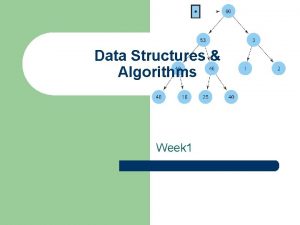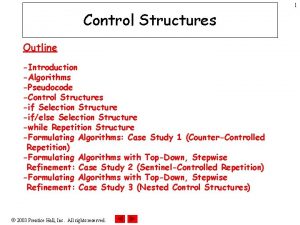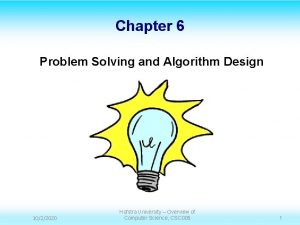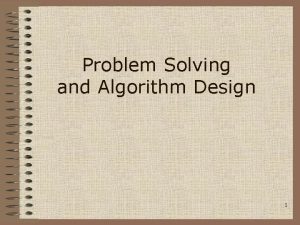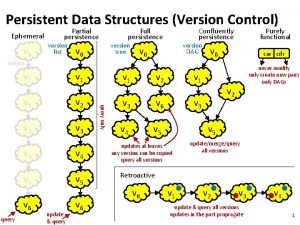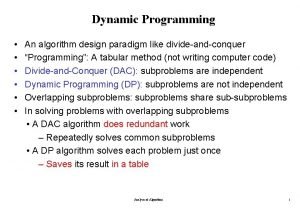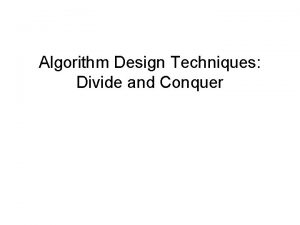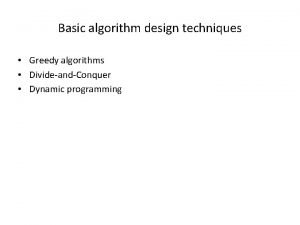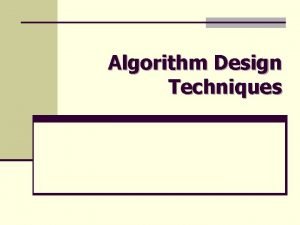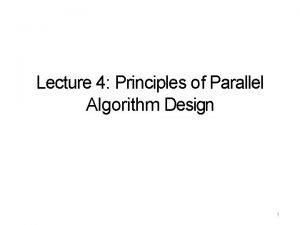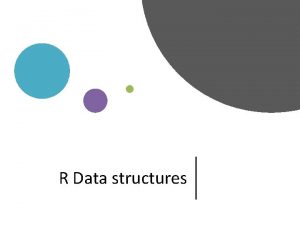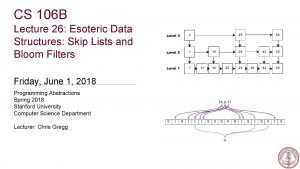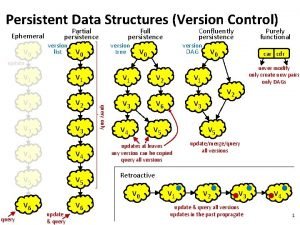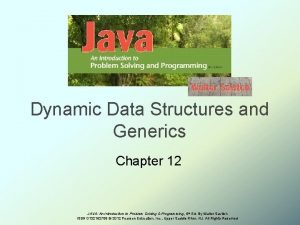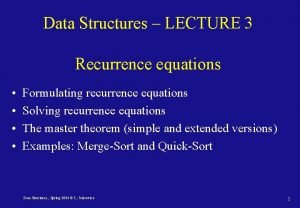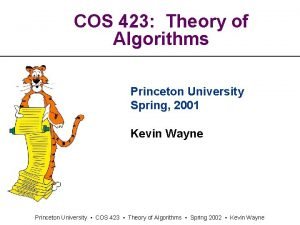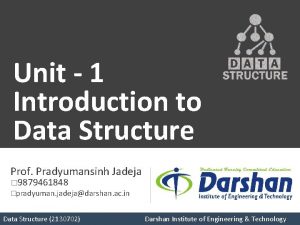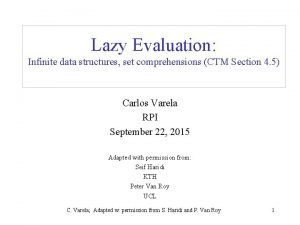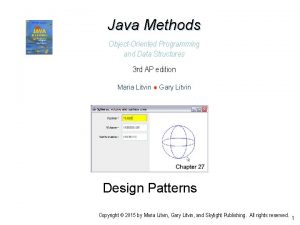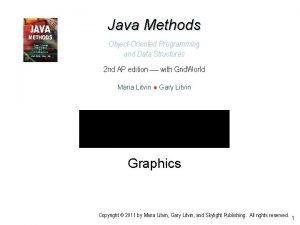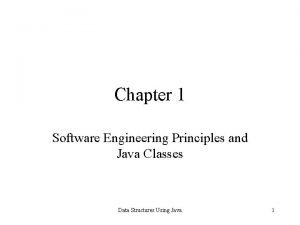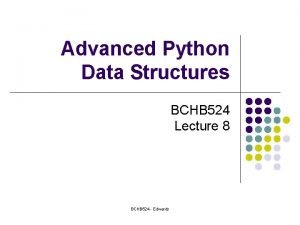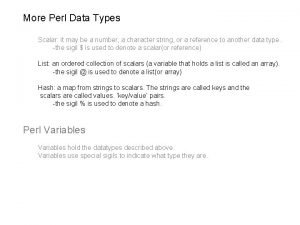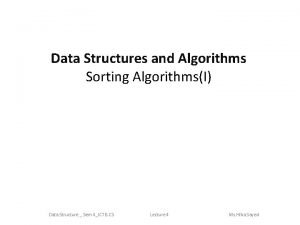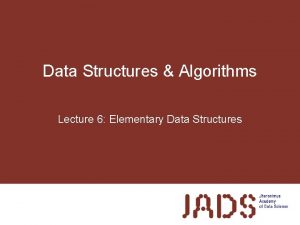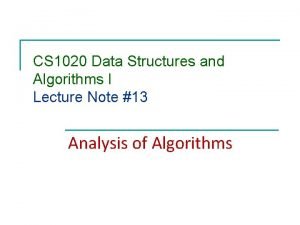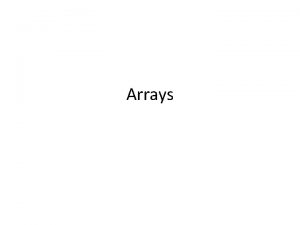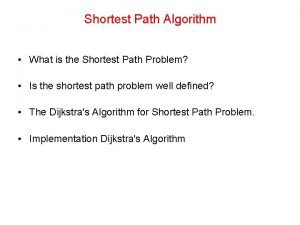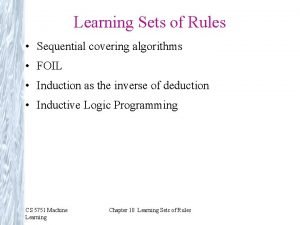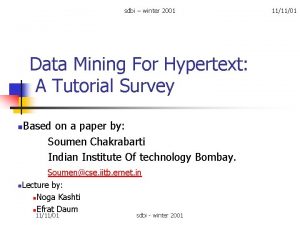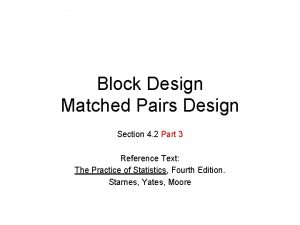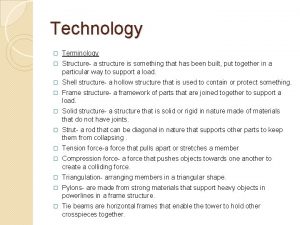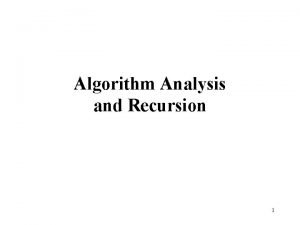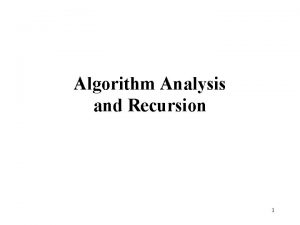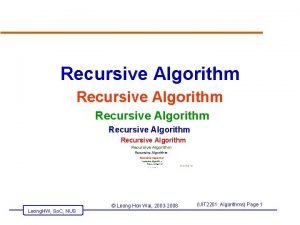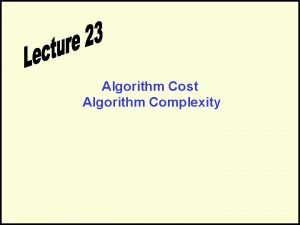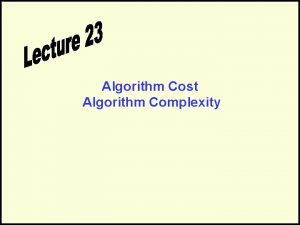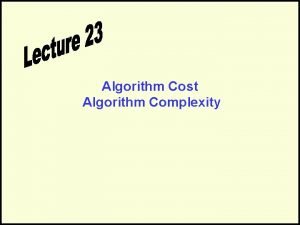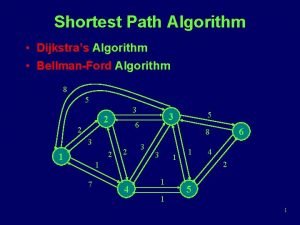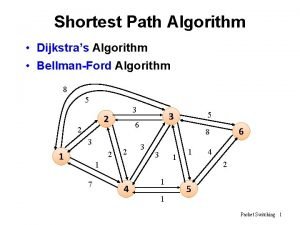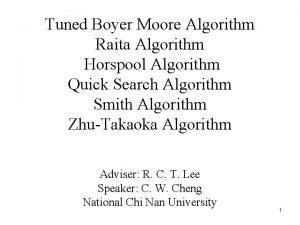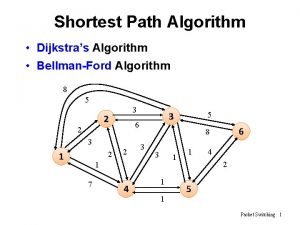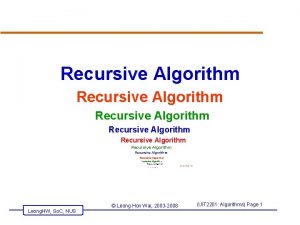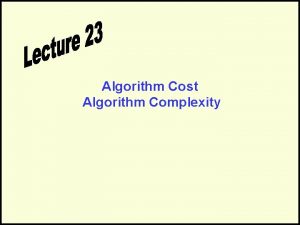Data Structures and Algorithm Design Review Data Structures
























![class Array. Queue implements Queue { private Object[] elem; private int front, rear; private class Array. Queue implements Queue { private Object[] elem; private int front, rear; private](https://slidetodoc.com/presentation_image/0331af9be31ab9a76b6e596d273a89e8/image-25.jpg)











![public class Generating. List { public static void main (String[] args) { String [] public class Generating. List { public static void main (String[] args) { String []](https://slidetodoc.com/presentation_image/0331af9be31ab9a76b6e596d273a89e8/image-37.jpg)
![public static Head. Tail linked. List(String[] b) { Node head = null; Node tail public static Head. Tail linked. List(String[] b) { Node head = null; Node tail](https://slidetodoc.com/presentation_image/0331af9be31ab9a76b6e596d273a89e8/image-38.jpg)











![public class Array. Vector implements Vector { private Object[] A; // array storing the public class Array. Vector implements Vector { private Object[] A; // array storing the](https://slidetodoc.com/presentation_image/0331af9be31ab9a76b6e596d273a89e8/image-50.jpg)
![public Object elem. At. Rank (int r) {return a[r]; } public int size() {return public Object elem. At. Rank (int r) {return a[r]; } public int size() {return](https://slidetodoc.com/presentation_image/0331af9be31ab9a76b6e596d273a89e8/image-51.jpg)





































































![XML File Algorithm: Scan array A; If A[i] is ‘<’ and A[i+1] is a XML File Algorithm: Scan array A; If A[i] is ‘<’ and A[i+1] is a](https://slidetodoc.com/presentation_image/0331af9be31ab9a76b6e596d273a89e8/image-121.jpg)











































- Slides: 164

Data Structures and Algorithm Design (Review)

Data Structures and Algorithm Design: Graphs Set operations Quick sorting Merge sorting Tree traversal Trees and binary trees Vectors, lists and sequences Stacks, queues, and deques Object-oriented design Java basics

Java Basics Class Modifiers abstract, final, public Variable Modifiers public, protected, private, static, final Methods Method Modifiers public, protected, private, abstract, final, static Arrays int[] a = new int[ 10 ]; float[][] x = new float[ 8 ][ 10 ]; a[ i ] = 138; x[ i ][ i + 1 ] = 2. 189 + x[ i ];

Object-Oriented Design Inheritance Polymorphism method overriding method overloading Keyword: this Exception Interface, Abstract Classes Type casting

Stacks, Queues, and Deques Stacks Queues Deques Singly linked lists Doubly linked lists Sample case study application

Stacks Definition: A stack is a container of objects that are inserted and removed according to the last-in first-out (LIFO) principle. A stack S is an abstract data type (ADT) that supports following two fundamental methods: push(o): Insert object o at the top of the stack Input: Object; Output: None. pop(): Remove from the stack and return the top object on the stack; an error occurs if the stack is empty. Input: None; Output: Object

public interface Stack { public void push( Object element ); public Object pop() throws Stack. Empty. Exception; public int size(); public boolean is. Empty(); public Object top() throws Stack. Empty. Exception; }

public class Array. Stack implements Stack { public static final int CAPACITY = 1000; private in capacity; private Object [] S; private int top = -1; public Array. Statck() { this( CAPACITY ); } public Array. Stack( int cap ) { capacity = cap; S = new Object[ capacity ]; } public int size() { return ( top + 1 ); }

public boolean is. Empty() { return( top < 0 ); } public void push( Object obj ) throws Stack. Full. Exception { if( size() == capacity ) throw new Stack. Full. Exception( "Stack overflow" ); S[ ++top ] = obj; } public Object top() throws Stack. Empty. Exception { if( is. Empty() ) throw new Stack. Empty. Exception( "Stack is empty. " ); return S[ top ]; }

public Object pop() throws Stack. Empty. Exception { Object elem; if( is. Empty() ) throw new Stack. Empty. Exception( "Stack is Empty. " ); elem = S[ top ]; S[ top-- ] = null; return elem; } }

public class Node. Stack implements Stack { protected Node top; // reference to the head node protected int size; // number of elements in the stack public Node. Stack() { // constructs an empty stack top = null; size = 0; } public int size() { return size; } public boolean is. Empty() { if (top == null) return true; return false; } public void push(Object elem) { Node v = new Node(elem, top); // create and link-in a top = v; //new node size++; }

public Object top() throws Empty. Stack. Exception { if (is. Empty()) throw new Empty. Stack. Exception("Stack is empty. "); return top. get. Element(); } public Object pop() throws Empty. Stack. Exception { if (is. Empty()) throw new Empty. Stack. Exception("Stack is empty. "); Object temp = top. get. Element(); top = top. get. Next(); // link-out the former top node size--; return temp; } }

Sample Case Study Application (1) We want to write a program to calculate the span of the stock’s price on a given day. The span of the stock’s price on a given day: The maximum number of the consecutive days up to the current day such that the stock price on each of those days has been less than or equal to the price on the current day.

Java Implementation

Main idea: The span si on a certain day i can be easily computed if we know the closest day preceding day i, such that the price on that day is higher than the price on day i. If such a preceding day exists for a day i, let us denote it with h(i), and otherwise let us define h(i) = -1. Then, si = i – h(i).

si = i – h(i). h(0) h(1) h(2) h(3) h(4) h(5) h(6) -1 0 1 1 3 1 0 s 1 1 s 2 1 s 3 2 s 4 1 s 5 4 s 6 6 s 0 1

The problem is how to compute h(i) efficiently? Step 1: p 0 = 48. 97. h(0) = -1, s 0 = 0 - h(0) = 0 – (-1) = 1 0 Day 0. It is possible that h(1) = 0. Step 2: p 1 = 47. 54. Pop days with prices less than or equal to p 1. At this point of time, we have only one element in the stack. It is 0 and p 0 > p 1. So h(1) = 0, s 1 = 1 - h(1) = 1 – 0 = 1. 1 0 Day 1. It is possible that h(2) = 1.

Step 3: p 2 = 45. 83. Pop days with prices less than or equal to p 2. At this point of time, we have two elements in the stack. The top one is 1 and p 1 > p 2. So h(2) = 1, s 2 = 2 - h(2) = 2 – 1 = 1. 2 1 Day 2. It is possible that h(3) = 2. 0 Step 4: p 3 = 46. 34. Pop days with prices less than or equal to p 3. The top one will be taken out since p 3 > p 2. The second one is 1 and p 1 > p 3. So h(3) = 1, s 3 = 3 - h(3) = 3 – 1 = 2. 3 1 0 Day 3. It is possible that h(4) = 3.

Step 5: p 4 = 45. 68. Pop days with prices less than or equal to p 4. The top one is 3 and p 3 > p 4. So h(4) = 3, s 4 = 4 - h(3) = 4 – 3 = 1. 4 3 Day 4. It is possible that h(5) = 4. 1 0 Step 6: p 5 = 46. 95. Pop days with prices less than or equal to p 3. The top two will be taken out since p 5 > p 4 and p 5 > p 3. The third one is 1 and p 1 > p 5. So h(5) = 1, s 5 = 5 - h(5) = 5 – 1 = 4. 5 1 0 Day 5. It is possible that h(6) = 5.

Step 7: p 6 = 48. 17. Pop days with prices less than or equal to p 3. The top two will be taken out since p 6 > p 5 and p 6 > p 1. The third one is 0 and p 0 > p 6. So h(6) = 0, s 5 = 6 - h(6) = 6 – 0 = 6. 6 0 Day 6. The price on day 6. The process stops.

(2) Calculate the following expression using Array. Stack to control the computation: “ 1+2+3 -4 -5+6 -7+8 -9”. public class Expression-computation{ //start class public static void main( String args[] ) //start main body {String s = "1+2+3 -4 -5+6 -7+8 -9"; Stack data = new Array. Stack(); int temp; char operator; int a = 0; data. push (new Integer (1)); for (int x = 1; x < s. length(); x++) { if (s. char. At(x) == '+‘ || s. char. At(x) == ‘-’) data. push(new Character(s. char. At(x))); else { //else it is a number

operator = (Character) data. pop(); a = ((Integer)data. pop()). int. Value(); if (operator == ‘+’) temp = a + char. At(x); else temp = a – char. At(x); data. push(new Integer(temp)); } System. out. println("The answer is: " + ((Integer) data. pop()). int. Value()); } // end method main }// end class

Queues Definition: A queue is a container of objects that are inserted and removed according to the first-in first-out (FIFO) principle.

![class Array Queue implements Queue private Object elem private int front rear private class Array. Queue implements Queue { private Object[] elem; private int front, rear; private](https://slidetodoc.com/presentation_image/0331af9be31ab9a76b6e596d273a89e8/image-25.jpg)
class Array. Queue implements Queue { private Object[] elem; private int front, rear; private static final int DEFAULT_LENGTH = 100; private int length; public Array. Queue() { this(DEFAULT_LENGTH); } public Array. Queue(int length) { elem = new Object[length]; front = rear = 0; length = elem. length; }

public void enqueue(Object element) throws Queue. Full. Exception { if (size()==length-1) throw new Queue. Full. Exception(); else { elem[rear] = element; rear = (rear+1)%length; } }

public Object dequeue() throws Queue. Empty. Exception { if (is. Empty()) throw new Queue. Empty. Exception(); else { Object temp = elem[front]; elem[front] = null; front = (front+1)%length; return temp; } } private boolean is. Full() { return (rear-front)==(length-1); }

public int size() { return (length-front+rear)%length; } public boolean is. Empty() { return front==rear; } public Object front() throws Queue. Empty. Exception { if (is. Empty()) throw new Queue. Empty. Exception(); else return elem[front]; } }

public class List. Queue implements Queue { protected Node front, rear; //reference to the front and rear node protected int size; // number of elements in the queue public List. Stack() { // constructs an empty queue front = null; rear = null; size = 0; } public int size() { return size; } public boolean is. Empty() { if (front == null) return true; return false; } public void enqueue(Object elem) { Node v = new Node(elem, null); //create and link-in a new node if (size == 0) {front = v; rear = v; } else {rear. set. Next(v); rear = v; size++; }

public Object front() throws Queue. Empty. Exception { if (is. Empty()) throw new Queue. Empty. Exception("Stack is empty. "); return front. get. Element(); } public Object dequeue() throws Queue. Empty. Exception { if (is. Empty()) throw new Queue. Empty. Exception(“Queue is empty. "); Object temp = front. get. Element(); front = front. get. Next(); // link-out the former front node size--; return temp; } } /** * Runtime exception thrown when one tries to perform operation * front or dequeue on an empty queue. */ public class Queue. Empty. Exception extends Runtime. Exception { public Queue. Empty. Exception(String err) { super(err); } }

Application case: A breadth-first search traverses a tree as shown in the following Figure. Write an algorithm (not a Java program) to search a tree in the breadth-first manner by using the queue data structure to control the process.

Algorithm: create a Queue Q; put root of the tree into Q; while (Q is not empty) { t Q. dequeue(); if (t’s left child is not a leaf) put t’s left child into Q; if (t’s right child is not a leaf) put t’s right child into Q; visit t; }

Singly Linked Lists

Class Node


How to generate a singly linked list? class Head. Tail { Node head; Node tail; Head. Tail(Node x, Node y) { head = x; tail = y; } }
![public class Generating List public static void main String args String public class Generating. List { public static void main (String[] args) { String []](https://slidetodoc.com/presentation_image/0331af9be31ab9a76b6e596d273a89e8/image-37.jpg)
public class Generating. List { public static void main (String[] args) { String [] arr 1 = {"Winnipeg", "Vancouver", "Bejing", "Athen“ "London", "Berlin", "Toronto", "Seattle“ "Rome", "Baltimore"}; Head. Tail a = linked. List(arr 1); Node x = a. head; while (x != null) { System. out. println(x. get. Element()); x = x. get. Next(); } }
![public static Head Tail linked ListString b Node head null Node tail public static Head. Tail linked. List(String[] b) { Node head = null; Node tail](https://slidetodoc.com/presentation_image/0331af9be31ab9a76b6e596d273a89e8/image-38.jpg)
public static Head. Tail linked. List(String[] b) { Node head = null; Node tail = null; Node x = null; for (int i = 0; i < b. length; i++) {x = new Node(); x. set. Element(b[i]); if (i == 0 ) {x. set. Next(null); tail = x; } else x. set. Next(head); head = x; } return new Head. Tail(head, tail); } }

Doubly Linked List Difference from singly linked lists: - each node contains two links. - two extra nodes: header and trailer, which contain no elements.

Class DLNode


Deques Definition: A double-ended queue is a queue that supports insertion and deletion at both the front and the rear of the queue. A deque D is an abstract data type that supports the following four fundamental methods:

public interface Deque { void insert. First(Object e); void insert. Last(Object e); Object remove. First(); Object remove. Last(); Object first(); Object last(); int size(); boolean is. Empty(); }

Class My. Deque

Vectors, Lists, and Sequences Vectors Lists Sequences Iterators

Vector (interface) extends impl. Array. Vector (class) extends List (interface) extends Sequence (interface) impl. Array. Sequence (class) impl. Node. List (class) extends Node. Sequence (class)


A Simple Array-Based Implementation Vector ADT Array rank index

Vectors public interface Vector { public int size(); public boolean is. Empty(); public Object elem. At. Rank(int r); public Object replace. At. Rank(int r, Object e); public void insert. At. Rank(int r, Object e); public Object remove. At. Rank(int r); }
![public class Array Vector implements Vector private Object A array storing the public class Array. Vector implements Vector { private Object[] A; // array storing the](https://slidetodoc.com/presentation_image/0331af9be31ab9a76b6e596d273a89e8/image-50.jpg)
public class Array. Vector implements Vector { private Object[] A; // array storing the elements of the vector private int capacity = 16; // initial length of array A private int size = 0; // number of elements stored in the vector /** Creates the vector with initial capacity 16. */ public Array. Vector() { A = new Object[capacity]; }
![public Object elem At Rank int r return ar public int size return public Object elem. At. Rank (int r) {return a[r]; } public int size() {return](https://slidetodoc.com/presentation_image/0331af9be31ab9a76b6e596d273a89e8/image-51.jpg)
public Object elem. At. Rank (int r) {return a[r]; } public int size() {return size; } public boolean is. Empty {return size()==0; } public Object replace. At. Rank (int r, Object e) { Object temp=a[r]; a[r]=e; return temp; }

/** Inserts an element at the given rank. */ public void insert. At. Rank(int r, Object e) throws Boundary. Violation. Exception { check. Rank(r, size() + 1); if (size == capacity) { // an overflow capacity *= 2; Object[] B = new Object[capacity]; for (int i=0; i<size; i++) B[i] = A[i]; A = B; } for (int i=size-1; i>=r; i--) // shift elements up A[i+1] = A[i]; A[r] = e; size++; }

/** Removes the element stored at the given rank. */ public Object remove. At. Rank(int r) throws Boundary. Violation. Exception { check. Rank(r, size()); Object temp = A[r]; for (int i=r; i<size-1; i++) // shift elements down A[i] = A[i+1]; size--; return temp; } public int size( ) {return size; }

Lists List: A container of elements that stores each element at a position and that keeps these positions arranged in a linear order. The position abstract data type supports only one simple method: public interface Position { Object element(); } The concept of position is similar to the concept of node in a doubly linked list.

Position element(); impl. Dnode element(){…}; get. Next(){…}; get. Prev(){…}; set. Next(){…}; set. Prev(){…}; set. Element(){…};



Doubly Linked List Implementation List ADT position Doubly linked list Dnode

public interface List { /** Returns the number of elements in this list. */ public int size(); /** Returns whether the list is empty. */ public boolean is. Empty(); /** Returns the first node in the list. */ public Position first(); /** Returns the last node in the list. */ public Position last(); /** Returns the node after a given node in the list. */ public Position next(Position p) throws Invalid. Position. Exception, Boundary. Violation. Exception; /** Returns the node before a given node in the list. */ public Position prev(Position p) throws Invalid. Position. Exception, Boundary. Violation. Exception;

/** Inserts an element at the front of the list. */ public Position insert. First(Object e); /** Inserts and element at the back of the list. */ public Position insert. Last(Object e); /** Inserts an element after the given node in the list. */ public Position insert. After(Position p, Object e) throws Invalid. Position. Exception; /** Inserts an element before the given node in the list. */ public Position insert. Before(Position p, Object e) throws Invalid. Position. Exception; /** Removes a node from the list. */ public Object remove(Position p) throws Invalid. Position. Exception; /** Replaces the element stored at the given node. */ public Object replace(Position p, Object e) throws Invalid. Position. Exception; }

Class Node. List








Sequence

In Java, the interface for sequences is an example of multiple inheritance: interface Sequence extends List, Vector { public Position at. Rank( int rank ) throws Boundary. Violation. Exception; public int rank. Of( Position position ) throws Invalid. Position. Exception; } Vector interface List interface Sequence interface

Implementation of a sequence with a doubly linked list: Sequence ADT Position rank Doubly linked list Node at. Rank(r) rank. Of(p)

/** Implementation of a sequence by means of a doubly linked list. */ public class Node. Sequence extends Node. List implements Sequence { /** Checks whether the given rank is in the range [0, n - 1] */ protected void check. Rank(int r, int n) throws Boundary. Violation. Exception { if (r < 0 || r >= n) throw new Boundary. Violation. Exception("Illegal rank: " + r); }

/** Returns the position containing the element at the given rank; * O(n) time. */ public Position at. Rank (int rank) { DNode node; check. Rank(rank, size()); if (rank <= size()/2) { // scan forward from the head node = header. get. Next(); for (int i=0; i < rank; i++) node = node. get. Next(); } else { // scan backward from the tail node = trailer. get. Prev(); for (int i=1; i < size()-rank; i++) node = node. get. Prev(); } return node; }

/** Gets an element at the given rank. */ public Object elem. At. Rank(int r) { return at. Rank(r). element(); } /** Returns the rank of a given position. */ public int rank. Of(Position p) { DNode node; node = header. get. Next(); for (int i=1; i < size(); i++) { if (p == node) return i; else node = node. get. Next(); } } }

/** Inserts an element at the given rank; O(n) time. */ public void insert. At. Rank (int rank, Object element) throws Boundary. Violation. Exception { check. Rank(rank, size() + 1); if (rank == size()) insert. Last(element); else { insert. Before(at. Rank(rank), element); } }

/** Removes the element stored at the given rank; O(n) time. */ public Object remove. At. Rank (int rank) throws Boundary. Violation. Exception { check. Rank(rank, size()); return remove(at. Rank(rank)); } public Object replace. At. Rank (int rank, object element) throws Boundadry. Violation. Exception { check. Rank(rank); return replace. Element(at. Rank(rank), element); } }

Implementing a Sequence with an Array

Iterator


An implementation of the Iterator is always related to container, i. e. , a vector, a list, or a sequence. The following is an exemplary implementation of the List Iterator. public class Position. Iterator implements Iterator { protected List list; // the underlying list protected Position cur; // the current (next) position public Position. Iterator() { } // default constructor public Position. Iterator(List L) { // preferred constructor list = L; if (list. is. Empty()) cur = null; // list is empty else cur = list. first(); // start with the first position }

public boolean has. Next() { return (cur != null); } public Object next() throws No. Such. Element. Exception { if (!has. Next()) throw new No. Such. Element. Exception("No next position"); Position to. Return = cur; if (cur == list. last()) cur = null; // no positions left else cur = list. next(cur); // move cursor to the next position return to. Return; } } class No. Such. Element. Exception extends Exception { public No. Such. Element. Exception() {super(); } public No. Such. Element. Exception(String s) { super(s); } }

In a similar way, we can establish an Element. Iterator as follows. public class Element. Iterator implements Iterator { protected List list; // the underlying list protected Position cur; // the current (next) position protected Object element. Cur; // the current (next) element public Element. Iterator() { } // default constructor public Element. Iterator(List L) { // preferred constructor list = L; if (list. is. Empty()) cur = null; // list is empty else cur = list. first(); // start with the first position }

public boolean has. Next() { return (cur != null); } public Object next() throws No. Such. Element. Exception { if (!has. Next()) throw new No. Such. Element. Exception("No next position"); element. Cur = cur. element(); if (cur == list. last()) cur = null; // no positions left else cur = list. next(cur); // move cursor to the next position return element. Cur; } }


Trees What is a tree? Tree ADT Basic algorithms on trees Tree traversal

What is a tree?

Tree Interface – Tree ADT public interface Tree { public int size(); public Boolean is. Empty(); public Element. Iterator elements(); public Position. Iterator positions(); public void swap. Elements( Position v, Position w ); public Object replace. Element( Position v, Object e ); public Position root(); public Position parent( Position v ); public Position. Iterator children( Position v ); public boolean is. Internal( Position v ); public boolean is. External( Position v ); public boolean is. Root( Position v ); }

Ispectable. Container size is. Elements Ispectable. Position. Container positions Inspectable. Tree root parent children is. Root is. Internal is. External Position. Container swap. Element replace. Element Tree

A Binary Tree Interface in Java


Data Structures for Representing Trees 1. Storing a binary tree in an array 2. Storing a tree as a linked list

1 2 3 4 5 6 7 8 9 10 11 12 13 14 15

Where a node v of tree T is stored can be determined as follows. Let p(v) be the index, where v is stored. The following relationships must be satisfied: If v is the root of T, then p(v) = 1. If v is the left child of the node u, then p(v) = 2 p(u) If v is the right child of the node u, then p(v) = 2 p(u) + 1.





a b e f c g d

Class BTNode

Interface Hierarchy for Positions Position element(); DNode element(){…}; get. Next(){…}; get. Prev(){…}; set. Next(){…}; set. Prev(){…}; set. Element(){…}; BTNnode element(){…}; get. Left(){…}; get. Right(){…}; set. Left(){…}; set. Right(){…}; get. Parent(){…} set. Element(){…};

Also see the complete program for “Linked. Binary. Tree” posted on the home page of Dr. Yangjun Chen.

Ispectable. Container size is. Elements Ispectable. Position. Container positions Position. Container swap. Element replace. Element Tree Inspectable. Tree root, parent, children, is. Root is. Internal, is. External Inspectable. Binary. Tree left. Child, right. Child, sibling Binary. Tree imple. Linked. Binary. Tree … …, replace. Element, swap. Element, expand. External, remove. Above. External

Basic Algorithms on Trees


Inorder tree traversal • Inorder traversal based on recursion:

inorder(T, r) inorder(T, u) inorder(T, w) if … inorder(T, u) “visit” r 6 inorder(T, w) “visit” u 2 “visit” w If … if … inorder (T, a) inorder (T, v) 1

inorder(T, v) inorder(T, x) if … inorder(T, x) “visit” v 4 If … inorder (T, y) “visit” x if … 3

inorder(T, y) if … “visit” y if … 5 inorder(T, a) if … inorder(T, a) inorder(T, b) “visit” a 8 If … inorder (T, c) 7 9

• Inorder traversal based on Stack data structure Algorithm Stack-control-inorder(T, v) establish stack S; S. push(v); while (S is not empty) do {u : = S. pop(); if u is leaf or u is marked, visit u; else {let v 1 and v 2 be the left and right child node of v, respectively; S. push(v 2); mark u; S. push(u*); S. push(v 1); } }

r x v* y r* a print(r) a u r* a w u* v r* a v* y print(x) r* a b a* c u* v print(w) r* a y print(v) r* a a* c v print(u) r* a print(b) print(y) print(a) c print(c)

Preorder Traversal • Preorder traversal based on recursion: Algorithm preorder(T, v): perform the “visit” action for node v for each child w of v call preorder(T, w) v postorder(T, w) w postorder(T, v)

Algorithm binary. Preorder(T, v): perform the “visit” action for node v if v is an internal node call binary. Preorder(T, T. left. Child( v )) call binary. Preorder(T, T. right. Child( v ))

• Preorder traversal based on Stack data structure Algorithm Preorder. On. Stack(BTree my. Tree, BNode v) { Establish a Stack my. Stack; my. Stack. push(v); While (my. Stack is not empty) do { u = my. Stack. pop(); visit(u); if ( u has right child) my. Stack. push(u. rightchild()); if ( u has left child) my. Stack. push(u. leftchild()); } }

Postorder Traversal • Postorder traversal based on recursion: Algorithm Postorder(T, v): for each child w of v call postorder(T, w) perform the “visit” action for node v v postorder(T, w) w postorder(T, v)

• Postorder traversal based on Stack data structure Algorithm Postorder. On. Stack(T, v): {establish stack D; D. push(D); while (D is not empty) do {u : = D. pop(); if u is leaf or marked, then visit u; else { let u 1, …, uk be the children of u; mark u; D. push(u); for (i = k; 0 <= i; i--) D. push(ui): } } }

Load a tree from disk into main memory File: a b e c f g d a; b, c, d. b; e, f. e; f; c; g. g; d;

a b c a d b e e f g public class Node 1 { String x; Node 2 y; } public class Node 2 { Node 1 x; Node 2 y; } f c g d

S. push(root, null); While (S is not empty) do { x : = S. pop( ); generate a node n for x. node_value; if x. point_to_parent is not null then generate links between n and x. point_to_parent; let x 1, …, xk be the children of x; for i = k to 1 do a; b, c, d. S. push(xi, n); b; e, f. } e; stack S: node_value Point_to_parent f; c; g. g; d;

XML File <book> <title> “The Art of Programming” </title> <author> “D. Knuth” </author> <year> “ 1969” </year> </book> <title> <author> “The Art of “D. Knuth” Programming” <year> “ 1969”

XML File Read a file into a character array A: < b o o k > < t i t l e > “ T h e A r t … stack S: node_value Point_to_node
![XML File Algorithm Scan array A If Ai is and Ai1 is a XML File Algorithm: Scan array A; If A[i] is ‘<’ and A[i+1] is a](https://slidetodoc.com/presentation_image/0331af9be31ab9a76b6e596d273a89e8/image-121.jpg)
XML File Algorithm: Scan array A; If A[i] is ‘<’ and A[i+1] is a character then { generate a node x for A[i. . j], where A[j] is ‘>’ directly after A[i]; let y = S. top(). pointer_to_node; make x be a child of y; S. push(A[i. . j], x); If A[i] is ‘ ‘‘ ’, then { genearte a node x for A[i. . j], where A[j] is ‘ ’’ ’ directly after A[i]; let y = S. top(). pointer_to_node; make x be a child of y; If A[i] is ‘<’ and A[i+1] is ‘/’, then S. pop();

Storing a tree onto disk i = 0 a d e i = 1 h i = 2 node 0 f b node 1 k file: a d e node 2 … … 0 1 2 3 4 5 6 7 8 9

Storing a tree onto disk i = 0 a d e i = 1 h i = 2 node 0 f b node 1 k file: a 1 4 d 2 3 e node 2 h … … … 0 1 2 3 4 5 6 7 8 9

Storing a tree onto disk We search a tree in preorder and use a special stack data structure to control the traversal in such a way the parent address can be recorded. parent address data flag to indicate left or right child

Storing a tree onto disk Algorithm storing-tree(T, v) -1 indicates that the corresponding establish stack S; i = 0; node is the root. S. push((v, 0, -1)) while (S in not empty) do { u : = S. pop(); store u. Data in address i*3; if (u. Parent-address is not equal to – 1) then {if (u. Flag == 0) then j : = 0; else j : = 1; store i in address (u. Parent-address)*3 + 1 + j; } let u 1, u 2 be the left and right child of u, respectively; S. push((u 2, 1, i)); S. push((u 1, 0, i)); i++; }

Merge Sort


The figure here shows how the sequence is divided in the previous example. 85 24 63 45 17 31 96 50 85 24 63 45 17 31 96 50 17 96 31 50

The figure here shows how the sequences are merged in the previous example. 17 24 31 45 50 63 85 96 24 45 63 85 24 85 85 24 45 63 63 45 17 31 50 96 17 96 31 50



Quick Sort








Java implementation (each time choose the middle element as the pivot. ) public class Sorter { public static void sort (int[] a, int from, int to) { if ((a == null) || (a. length < 2)) return; int i = from, j = to; int center = a[(from + to)/2]; do { while ((i < to) && (a[i] < center)) i++; while ((j > from) && (a[j] > center)) j--; if (i < j) { int tmp =a[i]; a [i] = a[j]; a[j] = tmp; } i++; j--; }while (i <= j); if (from < j) sort(a, from, j); if (i < to) sort(a, i, to); } }

The Set Abstract Data Type











Graphs and Graph Traversal








Data Structure for Graphs




 One pass macro processor
One pass macro processor Assembler data structures
Assembler data structures Data structures and algorithm
Data structures and algorithm Give other examples of homologous structures
Give other examples of homologous structures Difference between a star and ao star
Difference between a star and ao star What are commas for
What are commas for Repetition pseudocode example
Repetition pseudocode example Adri wessels
Adri wessels Chapter review motion part a vocabulary review answer key
Chapter review motion part a vocabulary review answer key Ap gov review final exam review
Ap gov review final exam review Nader amin-salehi
Nader amin-salehi Systematic review definition
Systematic review definition Narrative review vs systematic review
Narrative review vs systematic review Anany levitin
Anany levitin Brute force polynomial evaluation algorithm
Brute force polynomial evaluation algorithm Algorithm design and problem solving
Algorithm design and problem solving Problem solving and algorithm design
Problem solving and algorithm design Welding positions 6g
Welding positions 6g Input output design
Input output design Ajit diwan
Ajit diwan Cos 423 princeton
Cos 423 princeton Data structures and algorithms tutorial
Data structures and algorithms tutorial Information retrieval data structures and algorithms
Information retrieval data structures and algorithms Data structures and abstractions with java
Data structures and abstractions with java Data structures and algorithms bits pilani
Data structures and algorithms bits pilani Adts, data structures, and problem solving with c++
Adts, data structures, and problem solving with c++ Ajit diwan iitb
Ajit diwan iitb Data structures and algorithms
Data structures and algorithms Data structures and algorithms
Data structures and algorithms Ian munro waterloo
Ian munro waterloo Signature file structure in information retrieval system
Signature file structure in information retrieval system Ephemeral data structure
Ephemeral data structure Data structures and algorithms
Data structures and algorithms Scbf design example
Scbf design example Design of seismic-resistant steel building structures
Design of seismic-resistant steel building structures Advanced design of steel structures notes
Advanced design of steel structures notes Double angle section
Double angle section Sbu organizational structure
Sbu organizational structure Dynamic programming paradigm
Dynamic programming paradigm Algorithm design techniques
Algorithm design techniques Algorithm design techniques
Algorithm design techniques Algorithm design techniques with examples
Algorithm design techniques with examples Advanced algorithm analysis
Advanced algorithm analysis Principles of parallel algorithm design
Principles of parallel algorithm design Student data review and rosters
Student data review and rosters Student data review and rosters
Student data review and rosters Bubble matching digital logic
Bubble matching digital logic Preliminary design review example
Preliminary design review example Formal design reviews
Formal design reviews Critical design review
Critical design review Critical design review template
Critical design review template Critical design review
Critical design review Critical design review
Critical design review Gmp design review
Gmp design review Billy blue college of design reviews
Billy blue college of design reviews Formal design review
Formal design review Design review example
Design review example Refers to directional wave patterns
Refers to directional wave patterns Interim design review
Interim design review Final design review
Final design review Internal design review
Internal design review Cable installation design review
Cable installation design review Ebay website design review
Ebay website design review Design review presentation
Design review presentation Social impact statement for early design review
Social impact statement for early design review Pdr preliminary design review
Pdr preliminary design review Preliminary design review template
Preliminary design review template Conceptual design review template
Conceptual design review template Design review report
Design review report Conceptual design review
Conceptual design review Critical design review
Critical design review Cdr critical design review
Cdr critical design review Social impact statement for early design review
Social impact statement for early design review A decorative design or pattern
A decorative design or pattern Structural and decorative design
Structural and decorative design Process design and control design should always be in
Process design and control design should always be in User interface design in system analysis and design
User interface design in system analysis and design Bad mapping design examples
Bad mapping design examples Dialogue design in system analysis and design
Dialogue design in system analysis and design Www.btechsmartclass.com
Www.btechsmartclass.com Data structures in r
Data structures in r Oblivious data structures
Oblivious data structures Linux kernel map data structure
Linux kernel map data structure Introduction to data structures
Introduction to data structures Introduction to data structures
Introduction to data structures Esoteric data structures
Esoteric data structures Geometric data structures
Geometric data structures What is hadoop i/o
What is hadoop i/o Advanced data structures in java
Advanced data structures in java Debasis samanta data structure
Debasis samanta data structure Persistent vs ephemeral data structures
Persistent vs ephemeral data structures Php data structures
Php data structures Gis data structure types
Gis data structure types Linked list java
Linked list java Recurrence data structures
Recurrence data structures Structures in c ppt
Structures in c ppt Data structures for parallel computing
Data structures for parallel computing Data structures for language processing
Data structures for language processing Cos 423
Cos 423 Smart union algorithm in data structure
Smart union algorithm in data structure Stacks in data structures
Stacks in data structures Fundamentals of data structures in c
Fundamentals of data structures in c Prolog graph
Prolog graph Data structure classification
Data structure classification Polynomial addition using linked list in c
Polynomial addition using linked list in c Dynamic data structures
Dynamic data structures Hybrid data structures
Hybrid data structures Graphical user interface in data structures
Graphical user interface in data structures Java data structures
Java data structures Data structures chapter 1
Data structures chapter 1 Graphics data structures
Graphics data structures Algorithms + data structures = programs
Algorithms + data structures = programs Infinite data structures
Infinite data structures Data structures in java
Data structures in java Data structures in java
Data structures in java Data structures using java
Data structures using java Data structures using java
Data structures using java Advanced data structures in python
Advanced data structures in python Relational data structure
Relational data structure What is data structure
What is data structure Fundamentals of python data structures
Fundamentals of python data structures Elementary data structures
Elementary data structures Perl data types
Perl data types Queue is a static data structure
Queue is a static data structure Data structures
Data structures Data structures revision
Data structures revision Elementary data structures
Elementary data structures Nf1n
Nf1n 81/2 streaming
81/2 streaming Traversing algorithm in array
Traversing algorithm in array Find centroid of tree
Find centroid of tree Define shortest path
Define shortest path Induction as inverted deduction in machine learning
Induction as inverted deduction in machine learning International data encryption algorithm
International data encryption algorithm K-means clustering algorithm in data mining
K-means clustering algorithm in data mining Networks and graphs circuits paths and graph structures
Networks and graphs circuits paths and graph structures Subjective review of systems
Subjective review of systems Piggybacking in go-back-n arq
Piggybacking in go-back-n arq Data dictionary notation
Data dictionary notation Data flow diagram in system analysis and design
Data flow diagram in system analysis and design Data dictionary system analysis and design
Data dictionary system analysis and design Data dictionary example in system analysis and design
Data dictionary example in system analysis and design How to linearize a top opening parabola
How to linearize a top opening parabola Design and implementation of data plane
Design and implementation of data plane What is data dictionary in system analysis and design
What is data dictionary in system analysis and design Vce visual communication
Vce visual communication What is within participants design
What is within participants design Between groups design
Between groups design Within group design
Within group design Matched pairs design diagram
Matched pairs design diagram Experimental design
Experimental design Principles of design in interior design ppt
Principles of design in interior design ppt Repeated measures design
Repeated measures design Middle ages floral design
Middle ages floral design Differences between products and services
Differences between products and services Conceptual design database
Conceptual design database Design brief define
Design brief define While loops and if-else structures
While loops and if-else structures Virtualization structures/tools and mechanisms ppt
Virtualization structures/tools and mechanisms ppt Hardware and control structures
Hardware and control structures Homologous and analogous
Homologous and analogous Nims mac group
Nims mac group Is a cell phone tower a frame structure
Is a cell phone tower a frame structure Structures and mechanisms
Structures and mechanisms How do coordination structures help organize and measure
How do coordination structures help organize and measure


